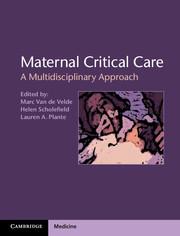
-
Select format
-
- Publisher:
- Cambridge University Press
- Publication date:
- 05 July 2013
- 04 July 2013
- ISBN:
- 9781139088084
- 9781107018495
- Dimensions:
- (246 x 189 mm)
- Weight & Pages:
- 1.54kg, 498 Pages
- Dimensions:
- Weight & Pages:
You may already have access via personal or institutional login
Book description
If you are an obstetrician whose patient has been admitted to ICU, you need to know how she is managed there. If you are an intensivist, you need to adapt to changes in physiology, alter techniques for the pregnant patient and keep the fetus from harm. This book addresses the challenges of managing critically ill obstetric patients by providing a truly multidisciplinary perspective. Almost every chapter is co-authored by both an intensivist/anesthesiologist and an obstetrician/maternal-fetal medicine expert to ensure that the clinical guidance reflects best practice in both specialties. Topics range from the purely medical to the organizational and the sociocultural, and each chapter is enhanced with color images, tables and algorithms. Written and edited by leading experts in anesthesiology, critical care medicine, maternal-fetal medicine, and obstetrics and gynecology, this is an important resource for anyone who deals with critically ill pregnant or postpartum patients.
Reviews
“…Provides a wide-ranging approach to factors complicating pregnancy. A focused book such as this is uncommon and I recommend it be housed in units that manage complications of pregnancy.”
- Doody's Review Service
Contents
Metrics
Full text views
Full text views help Loading metrics...
Loading metrics...
* Views captured on Cambridge Core between #date#. This data will be updated every 24 hours.
Usage data cannot currently be displayed.
Accessibility standard: Unknown
Why this information is here
This section outlines the accessibility features of this content - including support for screen readers, full keyboard navigation and high-contrast display options. This may not be relevant for you.
Accessibility Information
Accessibility compliance for the PDF of this book is currently unknown and may be updated in the future.


